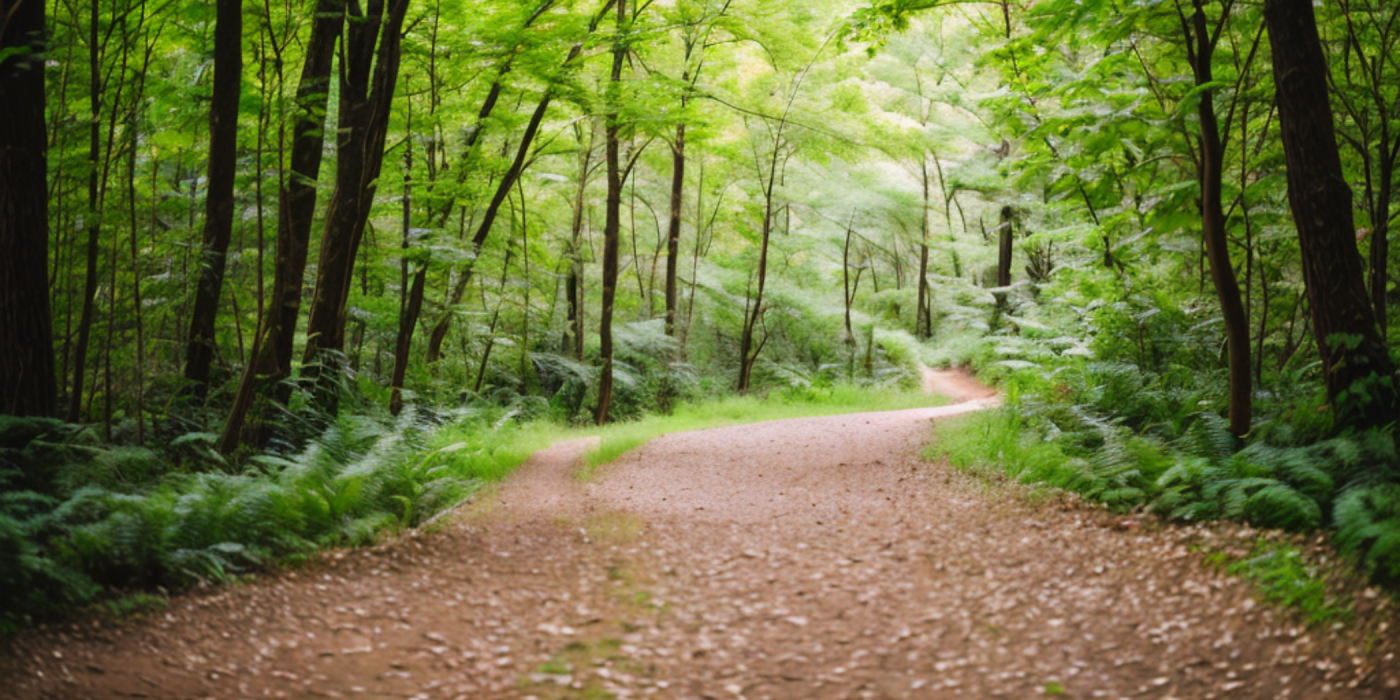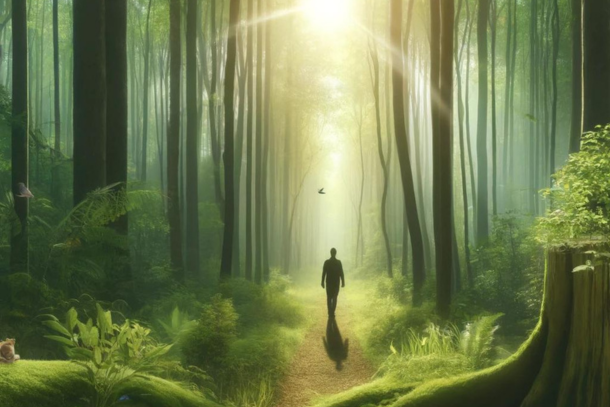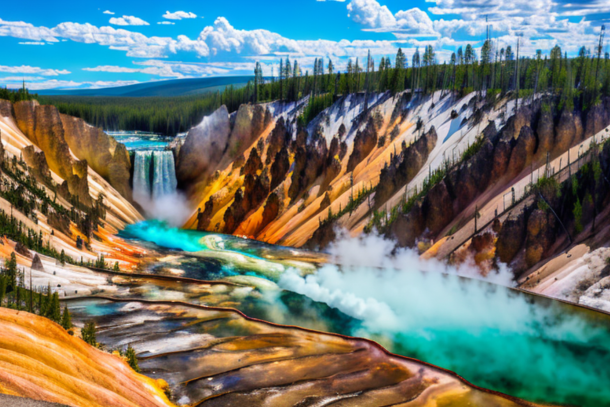Walking Through Time: The Historical Echoes of British Nature Trails

Wandering along a nature trail, one might easily be captivated by the beauty of the landscape, the rustling leaves, or the songs of the birds. But beyond these immediate sensory experiences lies a tapestry of tales, events, and memories deeply woven into the very soil and routes we tread upon. It's an intersection where nature collides beautifully with history.
Nature and History: The Inseparable Bond
The best nature trails aren't just pathways carved through forests or meadows; they're chronological corridors that have stood as silent witnesses to the passage of time. Imagine ancient traders walking their goods along these paths, or soldiers marching to the rhythm of war drums centuries ago. These trails have stories to tell, if only we're willing to listen.
Landscapes as Historical Testimonies
Every curve, incline, and stream along these trails has a story. The positioning of a boulder, the presence of an old, twisted tree, or the ruins of an unrecognisable structure - all serve as subtle markers of events past. Over time, these natural landmarks have intertwined with human narratives, creating a blend where history moulds the landscape and vice versa.
In the UK, our verdant hills, serene lakes, and winding pathways are more than just postcard-perfect scenes; they're chronicles of our heritage. And as we embark on our journey through these trails, we're not just walking; we're time-travelling, uncovering layers of stories that have shaped our present.
The Importance of Nature Trails in Historical Context
Nature's Pathways through Time
Every step taken on a nature trail is a dance with history. These trails, winding through the lush greenery and rugged terrains, have silently witnessed human civilisation's evolving saga. They have borne the weight of migrating tribes seeking new homes, merchants trading exotic wares, armies marching towards decisive battles, and pilgrims on spiritual quests.
Consider the ancient pathways like the Icknield Way, believed to be Britain's oldest road. It tells tales of prehistoric man, trade, and connections between distant regions. Then there's the famous Pilgrim’s Way, a historic route taken by countless pilgrims to the cathedral at Canterbury. Such trails have been, in essence, the arteries of our nation, facilitating movement and cultural exchange.
Guardians of Shared Heritage
However, the significance of these trails isn't limited to their historical utility. They stand as poignant reminders of our shared past, a testament to the resilience and ambition of our forebears. Each worn stone or compressed patch of earth resonates with stories of hope, conflict, discovery, and faith. By preserving these trails, we're not merely conserving a patch of land; we're safeguarding a legacy.
The onus, therefore, lies with us – the present custodians of these chronicles of time – to protect and honour them. As we walk these paths, it's vital to remember the immeasurable historical value they hold and ensure they continue to tell their tales for generations to come.
Notable British Trails with Historical Backgrounds
The British Isles are steeped in history, with tales from bygone eras echoing through every grove, moor, and glen. Nature trails, often traversing landscapes unaltered by time, serve as tangible links to these ancient tales. Let's embark on a journey, uncovering the tales of three such iconic pathways.
Hadrian's Wall Path
Winding its way across Northern England, the Hadrian's Wall Path follows the remnants of the Roman Empire's northern frontier. Constructed in AD 122 under Emperor Hadrian's reign, this monumental stone barrier served to keep the northern tribes at bay and marked the edge of Rome's dominion.
- Historical Highlights: Ancient Roman forts, bathhouses, and milecastles dot the route, each offering a unique glimpse into Roman life and architecture.
Offa's Dyke Path
Stretching between the English and Welsh borders, the Offa's Dyke Path traces a linear earthwork, believed to have been constructed by King Offa of Mercia in the 8th century. Originally built as a defensive ditch and rampart, today it stands as a testament to ancient territorial disputes and the enduring spirit of the Celts.
- Historical Highlights: The path wends past centuries-old churches, hill forts, and picturesque medieval towns that have stories to tell.
The Ridgeway
Often hailed as Britain's oldest road, The Ridgeway has seen travellers for over 5,000 years. Traversing ancient landscapes of chalk downs and woodland, this prehistoric trail once facilitated trade and pilgrimage between the regions.
- Historical Highlights: Along this route, one can find mysterious long barrows, hill figures, and Iron Age forts, encapsulating millennia of history and tradition.
The Layers of History Beneath Our Feet
As we tread the winding paths of Britain's nature trails, it's easy to become engrossed in the immediate beauty of the landscape. Yet, every step we take is a journey through time, a communion with centuries, if not millennia, of history layered beneath us. Two especially riveting aspects of this historical tapestry are the geological tales of the land and the archaeological remnants of those who walked before us.
Geological History: The Formation of the Landscape
The British Isles, with their diverse topography, tell a story that spans hundreds of millions of years. From the craggy peaks of the Highlands moulded by ancient volcanic activity to the rolling chalk downs shaped by the skeletal remains of tiny sea creatures, each contour and rock formation narrates an epoch. Understanding the geological transformations – the tectonic movements, glaciations, and erosions – not only enriches our appreciation of the scenery but also connects us to the primal forces that have sculpted our homeland.
Archaeological Wonders: Echoes from the Past
As we move from the bedrock tales of geology, the land offers up more recent, yet equally captivating, stories. Scattered along these trails are artefacts and remnants – stone tools, ancient coins, or pottery shards – that hint at the lives of those who roamed these parts in bygone eras. These archaeological finds serve as tangible links to our ancestors, be it the Romans who left their mark with roads and forts or earlier tribes whose barrows and standing stones punctuate the countryside. They whisper of wars, rituals, daily life, and the inexorable march of time.
Role of Local Historians & Communities
Amidst the verdant meadows and winding paths of Britain's nature trails, there lies a tapestry of stories and events that shaped our nation. These tales, though deeply rooted in the landscape, might have faded into obscurity if not for the dedication of local historians and the communities they belong to.
Guardians of the Past: Local Historians
In every village, town, or city, there often resides a passionate individual or group with a fervent dedication to preserving the annals of the past. Local historians, armed with both academic research and tales passed down through generations, work tirelessly to ensure the longevity of our shared history. They trawl through archives, interview older community members, and often organise events to ensure that the rich tapestry of stories from yesteryears remains vivid and relevant.
While trail guides and history books offer a structured and often broader understanding, it's the local historian who provides the colour, texture, and intimacy to these tales, illuminating the subtle nuances that are often lost in wider narratives.
Oral Traditions & Storytelling: A Living Memory
Oral traditions play a pivotal role in history, especially in areas where written records are sparse or non-existent. These spoken stories, passed from one generation to the next, are a testament to the power of memory and the human desire to connect with our roots. Community gatherings, storytelling sessions, and even casual conversations in a local pub can serve as conduits for these precious narratives. By keeping these stories alive, communities ensure that their identity, values, and shared experiences continue to resonate, even as the sands of time shift beneath our feet.
Benefits of Integrating Historical Learning into Nature Walks
Nature walks, in themselves, offer a refreshing escape, a chance to reconnect with the Earth's wonders. But when we intertwine this experience with historical insights, we transform a simple stroll into a journey through time.
Enriching the Experience
Walking through a trail isn't just about the trees, flowers, or the path itself; it's also about the tales these paths could tell if they could speak. When you understand the footsteps you're retracing, whether they be those of Roman soldiers, ancient traders, or pilgrims, the landscape around you takes on a deeper significance. The whispering winds might carry the echoes of ancient chants, and the worn paths might reveal the weight of countless footsteps from epochs past.
Experiential Learning in History Education
Traditional classroom-based history education, while essential, often limits learners to the confines of textbooks and static images. Experiential learning, on the other hand, allows history to come alive. Feeling the unevenness of cobblestones, gazing upon centuries-old inscriptions, or even breathing in the air of a significant battleground can make historical events tangible and relatable.
This hands-on approach fosters a deeper connection and respect for the events and figures of the past. Moreover, it caters to varied learning styles, making history more accessible and engaging for everyone, from the most passionate historian to the casually curious walker.
In conclusion, intertwining history with our nature walks isn't just an enhancement; it's an invitation to see, feel, and cherish the rich tapestry of stories our land has witnessed.
Accessing Information: Trail Guides and More
In an era where knowledge is at our fingertips, accessing historical information about nature trails has never been easier. Whether you're an avid historian or just a curious walker, there are a plethora of resources available to enrich your experience.
Traditional Trail Guides
For many, there's nothing quite like the tactile experience of flipping through a trail guide. These guides, often available at local bookstores or tourist information centres, provide invaluable insights. Maps, historical photographs, and detailed accounts of past events can transport you back in time, allowing you to walk the trail with a more informed perspective. Renowned publications, such as the Ordnance Survey's series, often incorporate historical details, ensuring that hikers are well-informed about the trail's past significance.
The Digital Age: Apps, Websites, and QR Codes
While traditional guides have their charm, technology offers dynamic ways to delve into history:
-
Apps: Numerous mobile applications, tailored for the UK's rich history, blend interactive maps with multimedia presentations, offering historical context at your fingertips.
-
Websites: Many historical societies and local communities maintain websites dedicated to their trails, offering deep dives into historical events, figures, and landmarks.
-
QR Codes: Increasingly, trails are incorporating QR codes on informational signposts. Scanning these with a smartphone can instantly pull up additional information, be it video documentaries, oral histories, or digitalised primary sources.
In conclusion, there's a wealth of resources available for those keen to unravel the historical threads of the UK's nature trails. Whether you're a fan of physical guides or digital tools, the journey into the past awaits.
Preservation and Respect
In our excursions into the beauty of nature intertwined with history, it is essential that we recognise our roles as custodians of these precious narratives. Every stone, path, and relic on these trails tells a tale, holding whispers of days gone by. With such profound significance, comes the duty of preservation and an inherent respect for these sites and artefacts.
Safeguarding Historical Monuments and Artefacts
Across the UK, there are countless sites that bear witness to our shared history. These areas range from ancient burial mounds to remnants of industrial revolutions, each providing a tangible link to the past. Such sites and their accompanying artefacts, delicate as they might be, must be handled with the utmost care. In many instances, centuries or even millennia have seen these remnants withstand the elements. Yet, it takes but a moment of carelessness to cause irrevocable damage.
Visitor Responsibility: The 'Leave No Trace' Principle
As visitors, it's vital to adopt the 'leave no trace' mindset. This principle extends beyond merely not leaving litter or disturbing wildlife. It encompasses respecting boundaries, not touching or removing artefacts, and not leaving any marks that might detract from the historical integrity of a site. Our responsibility is to ensure that these historical treasures are left intact for future generations to appreciate and learn from.
In essence, as we tread the paths of our ancestors, let us move with a light foot and a heavy appreciation for the tales that unfold beneath our feet, ensuring that history remains undisturbed, echoing its lessons for years to come.
Engaging with History Beyond the Trails
The winding paths of nature trails often lead us through landscapes teeming with historical whispers. Yet, while these trails offer a tactile experience, there's much more to uncover when we step off the beaten path.
Local Museums and Heritage Centres
There's something truly special about walking into a local museum or heritage centre. Here, history is carefully curated, ensuring that tales of old are not forgotten but celebrated. These establishments often house artefacts, documents, and exhibits, offering a more in-depth perspective on the region's past. Whether it's ancient pottery shards from a bygone civilisation or a vintage photograph of the very trail you've just traversed, these pieces of history offer a tangible connection to the generations that have walked before us.
Historical Landmarks
Britain is dotted with landmarks that have borne witness to significant events and eras. From ancient stone circles to remnants of industrial revolution-era factories, these sites echo with stories of triumph, tragedy, innovation, and everyday life. While a nature trail might guide you past these landmarks, taking the time to delve deeper can offer invaluable insights.
Joining Historical Societies and Groups
For those truly captivated by the past, joining a historical society or group can be a rewarding endeavour. Beyond mere knowledge, these societies offer community – a collective of individuals united by their passion for history. Engaging in group tours, lectures, and re-enactments, members can immerse themselves fully, not just learning about history but living it, if only for a moment.
In essence, while our trails offer a window to the past, it's by engaging more profoundly with these supplementary resources that we truly grasp the depth and richness of our shared history.
It's quite the marvel, the intricate dance between the sprawling landscapes of the British isles and the chapters of history they've silently witnessed. These verdant trails and rugged terrains are not mere passageways in nature; they're time portals, offering glimpses into the epochs gone by.
Nature and History: Inextricable Ties
Our natural landscapes have borne witness to countless tales – from ancient battles and romantic legends to pioneering explorations and societal evolutions. Every step on a historical trail is, in essence, a walk through time. Each rustle of the leaves, whisper of the wind, and murmur of the brooks tells tales of yore, echoing the footsteps of those who walked before us.
An Invitation to Exploration
And so, as you lace up your hiking boots or plan your next outdoor excursion, remember that you're not just venturing out to relish nature's splendour. You're stepping into a rich tapestry of stories, waiting to be unravelled. Delve a bit deeper, scratch a tad beneath the surface, and what unfolds is a treasure trove of historical knowledge. Whether it's through the pages of a trail guide, the anecdotes of a local historian, or the ancient markings on a standing stone, there's always a story waiting to enrich your journey.
So, here's an invitation: Wander with curiosity. Traverse with reverence. And let the histories of our cherished landscapes further illuminate your outdoor adventures.
I do hope you have enjoyed this article and hope that you will subscribe to my newsletter so you can get the latest information about all things naturally relaxing.
Stay in touch, join the Naturally Relaxing Newsletter
Newsletter Signup
Post Your Comments
or post as a guest
Be the first to comment.
Latest articles in Nature

Exploring the UK’s Most Serene Coastal Trails

The Healing Power of Nature: Forest Bathing Explained

Sustainable Gardening: Tips for Growing Your Own Herbs

The Yellowstone Supervolcano: A Sleeping Giant

The Lost City of Atlantis: A Geological Mystery






